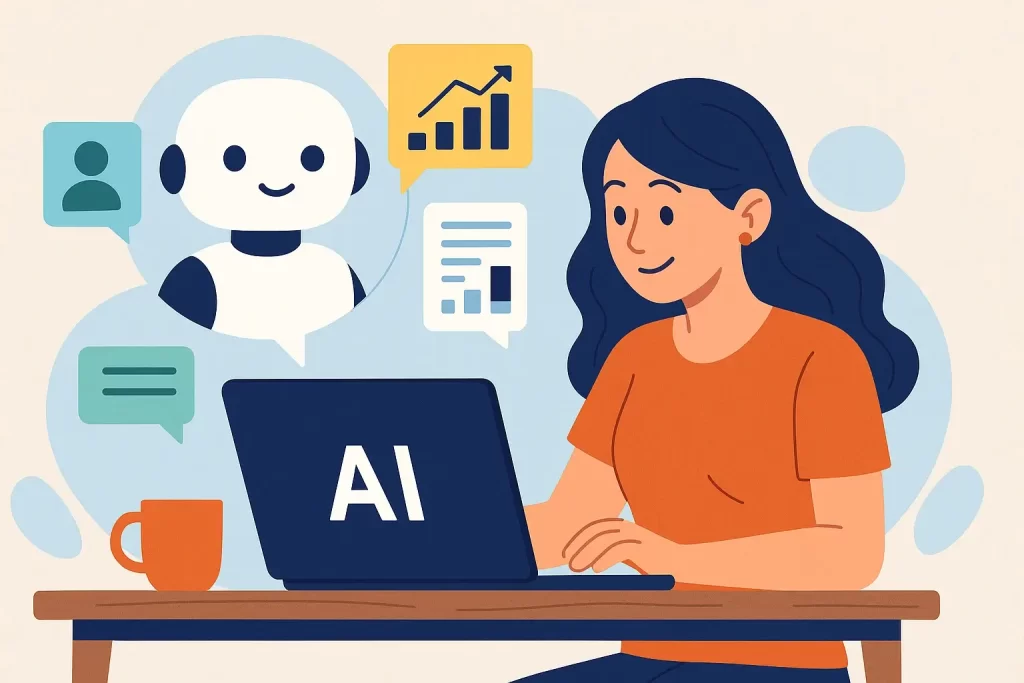
“They say it takes years to master a skill. But using this framework, we mastered AI Tools driven personalization in a fraction of the time. Here’s how it works (so you can too).”
How I stopped guessing and started connecting with AI Tools
You know that feeling when a brand seems to get you?
They recommend the exact product you wanted. Their emails feel personal. The content? Like it was written just for you.
It’s not luck. It’s AI.
I used to run campaigns based on gut feeling. Some worked. Some didn’t. But when I started using AI tools, something changed. Suddenly, I had data I could actually use. I saw what people wanted—and gave it to them.
You can do the same. Here’s how.
First: Why use AI Tools at all?
Because your audience expects more. They don’t want generic. They want relevant. Fast.
AI tools let you deliver just that.
They analyze behavior. Predict preferences. Customize content. And they don’t sleep.
You can personalize at scale—without burning out your team.
Let’s break it down.
Take this quick quiz to see how well you understand the power of AI in delivering personalized customer experiences. Ready to test your knowledge?
AI Tools for Personalization
Think of personalization as more than just adding a first name to an email.
With AI, you can show different messages to different people—automatically. Based on what they clicked, searched, bought, or ignored.
Real example?
I once ran a promo email to my whole list. CTR was okay.
Then I split it using an AI-powered CRM. One version for new visitors. One for returning buyers. One for cart abandoners.
The results? 3x more clicks. Almost double the revenue.
And I didn’t write three different campaigns. The tool adapted content on its own.
AI Tools for Data Analysis
Data is great. Until you have too much of it.
That’s where AI shines.
It sorts through the chaos. Finds patterns. Gives you insights you’d miss on your own.
Want to know when your customers are most likely to open emails? What topics drive more clicks? What products are trending next week?
AI tools can tell you. Without hours in spreadsheets.
My tip?
Start simple. Feed your data into one tool—HubSpot, Salesforce, Google Analytics (with AI enabled). Let it show you the patterns. Then act.
You’ll start noticing shifts in what people want. That’s where the magic starts.
AI Tools for Content
Content creation used to eat up my time.
I’d spend days writing, editing, testing headlines.
Now? I use AI to outline, draft, and even test content before it goes live.
Is it perfect? No. But it’s fast. And when I add my voice on top, it works even better.
Here’s what I use:
Jasper for writing first drafts
Surfer SEO for optimizing blog posts
Chat-based tools for brainstorming angles
Headline testers to A/B titles for newsletters
I still bring the human touch. But AI helps me move faster and smarter.
So, what tools should you try?
Here are a few I’ve tested and liked:
1. HubSpot
Their AI tools inside the CRM are solid. Great for email automation, content personalization, and customer segmentation. You can customize campaigns based on real behavior.
- Try it: HubSpot AI tools
2. Dynamic Yield
This one’s gold for websites. It changes what people see based on their past visits. Great if you’re running an e-commerce brand or product-led business.
- Try it: Dynamic Yield
3. Salesforce Einstein
If you’re already on Salesforce, you’re sitting on a smart engine. Einstein helps predict what customers want and automates messaging around that.
- Try it: Salesforce Einstein
4. Google Recommendations AI
Perfect for online stores. It learns what people browse and suggests similar products, kind of like Netflix, but for shopping.
5. Personyze
Think website personalization at scale. It adapts content, banners, and calls-to-action depending on the user.
- Try it: Personyze
Try one. You don’t need to adopt all at once. Pick the one that fits your workflow and test it.
AI & Marketing Tools Table
1. SEO Tools
| Tool | Free/Paid | Approx. Price |
|---|---|---|
| SEMrush | Paid | $129.95+/mo |
| Moz | Free & Paid | $99+/mo |
| Ahrefs | Paid | $99+/mo |
| SpyFu | Paid | $39+/mo |
| WooRank | Paid | $59.99+/mo |
| Screaming Frog | Free & Paid | $259/year |
| Labrika | Paid | $15+/mo |
| Google Search Console | Free | Free |
2. Email Marketing & CRM
| Tool | Free/Paid | Approx. Price |
|---|---|---|
| Mailchimp | Free & Paid | $13+/mo |
| ActiveCampaign | Paid | $29+/mo |
| GetResponse | Free & Paid | $15+/mo |
| UpViral | Paid | $49+/mo |
| Encharge | Paid | $49+/mo |
3. Advertising & Campaigns
| Tool | Free/Paid | Approx. Price |
|---|---|---|
| Google Ads | Paid | $5+/day |
| Bing Ads | Free & Paid | $5+/day |
| Facebook Ads | Paid | $5+/day |
| YouTube Ads | Paid | $10+/day |
| Adzooma | Free & Paid | $99+/mo |
| Marpipe | Paid | $1000+/mo |
4. Automation & Workflow Tools
| Tool | Free/Paid | Approx. Price |
|---|---|---|
| Zapier | Free & Paid | $19.99+/mo |
| Pabbly Connect | Free & Paid | $19+/mo |
| Connectio | Paid | $37+/mo |
| LeadConnect | Paid | $22+/mo |
5. AI Writing & Content Tools
| Tool | Free/Paid | Approx. Price |
|---|---|---|
| Jasper | Paid | $49+/mo |
| Copymatic | Free & Paid | $19+/mo |
| Copysmith | Paid | $19+/mo |
| Grammarly | Free & Paid | $12+/mo |
| Surfer | Paid | $89+/mo |
| MarketMuse | Paid | $149+/mo |
6. Video, Design, and Social Tools
| Tool | Free/Paid | Approx. Price |
|---|---|---|
| Canva | Free & Paid | $12.99+/mo |
| InVideo | Free & Paid | $15+/mo |
| InShot | Free & Paid | $3.99+/mo |
| Wave.video | Free & Paid | $20+/mo |
| Flick | Paid | $11+/mo |
| Iconosquare | Paid | $59+/mo |
| Biteplay | Paid | $29+/mo |
7. Ecommerce & Funnel Builders
| Tool | Free/Paid | Approx. Price |
|---|---|---|
| ClickFunnels | Paid | $97+/mo |
| Funnelytics | Free & Paid | $49+/mo |
| Dukaan | Paid | $9.99+/mo |
| Shopify | Paid | $39+/mo |
| Oberlo | Free | Free |
| Kajabi | Paid | $149+/mo |
8. Analytics & Tagging
| Tool | Free/Paid | Approx. Price |
|---|---|---|
| Google Analytics | Free | Free |
| Google Tag Manager | Free | Free |
| Google Data Studio | Free | Free |
| YouTube Analytics | Free | Free |
9. Project Management & Productivity
| Tool | Free/Paid | Approx. Price |
|---|---|---|
| Trello | Free & Paid | $5+/mo |
10. Social Media Tools & Management
| Tool | Free/Paid | Approx. Price |
|---|---|---|
| TweetDeck | Free | Free |
| Zlappo | Paid | $9+/mo |
| RetargetKit | Paid | $9+/mo |
| Taplink | Free & Paid | $3+/mo |
11. Podcast, Voice & Audio Tools
| Tool | Free/Paid | Approx. Price |
|---|---|---|
| bCast | Paid | $15+/mo |
| Listnr | Paid | $9+/mo |
12. App Builders & Miscellaneous Tools
| Tool | Free/Paid | Approx. Price |
|---|---|---|
| Andromo | Paid | $8+/mo |
| Swipe Pages | Paid | $29+/mo |
| BotStar | Free & Paid | $15+/mo |
| Hunter | Free & Paid | $49+/mo |
Why personalization matters
Let’s be honest—people ignore boring stuff.
If your content isn’t relevant, it won’t get clicks. If your site feels generic, they’ll bounce.
But when you personalize, they stick around.
Think about it:
Netflix keeps you watching because the recommendations feel right.
Spotify nails your mood with Discover Weekly.
Amazon? It knows what you’ll buy before you do.
These aren’t happy accidents. They’re powered by AI, and they build loyalty.
{
“@context”: “https://schema.org”,
“@type”: “VideoObject”,
“name”: “AI for Marketing: Automate Campaigns and Personalization at Scale”,
“description”: “Leveraging AI for marketing can significantly enhance the effectiveness and efficiency of campaigns.”,
“uploadDate”: “2025-05-09T05:30:00+05:30”,
“duration”: “PT58M23S”,
“thumbnailUrl”: “https://img.youtube.com/vi/vZSM_W1LW-k/maxresdefault.jpg”,
“contentUrl”: “https://www.youtube.com/watch?v=vZSM_W1LW-k”,
“embedUrl”: “https://www.youtube.com/embed/vZSM_W1LW-k”
}
Key Takeaways:
Learn how AI automates and optimizes marketing campaigns in real time.
Understand how to use AI for audience segmentation and personalized marketing at scale.
Gain skills to assess and enhance campaign performance using AI analytics tools.
Session delivered by ICTC in collaboration with Microsoft.
What happens when you use personalization well?
Here’s what I’ve noticed in my work:
Higher engagement
People click more when content feels tailored. I’ve seen email open rates jump by 25% just by tweaking subject lines using AI recommendations.
More conversions
Product suggestions based on behavior convert better. One of my clients added a personalized “You might like” section and saw a 12% lift in sales.
Better retention
When users feel understood, they return. Personalization turns one-time visitors into fans.
How to get started
Don’t wait until you have perfect data. You can start small and scale up.
Step 1: Collect better data
Track how people use your site. What do they click? Where do they drop off? Tools like Google Analytics 4 or Hotjar (for heatmaps) help you understand this.
Step 2: Segment your audience
Not all customers are the same. Split your list into types—new, loyal, cart abandoners, etc. AI can automate this inside tools like HubSpot or Klaviyo.
Step 3: Create smart content
Use AI to help with:
Personalized subject lines
Dynamic product suggestions
Even your homepage can adapt based on who’s visiting.
Step 4: Test and improve
Let AI show you what’s working. Check metrics like CTR, conversion rate, bounce rate. Adjust. Rinse. Repeat.
Step 5: Be transparent
Tell users what data you collect. Ask for consent. Let them opt out.
Trust is part of personalization.
What if you’re just starting out?
You don’t need big budgets.
Even free tools like Mailchimp or Canva offer basic personalization features.
Use them.
Here’s a beginner-friendly combo I recommend:
Mailchimp for personalized email flows
Google Analytics for basic user data
Canva’s Magic Write for quick content
Notion AI for internal brainstorming and briefs
That’s more than enough to start seeing results.
A few lessons I’ve learned along the way
Don’t overthink it. Your first campaign won’t be perfect. Ship it anyway.
Start with one audience segment. Maybe returning customers. Focus there before trying to personalize everything.
Use AI to support, not replace. It’s your brain. Not your boss.
Watch for burnout. AI tools help reduce the manual grind. Let them.
You’re not behind—just ready
If you’re reading this and thinking, “I haven’t started yet,” that’s fine.
Everyone starts somewhere. The key is starting with one small shift. One tool. One test.
AI isn’t just for big tech companies. It’s for solo marketers, small teams, and scrappy brands too.
And when you use it right, it helps you do the one thing that never goes out of style:
Treat people like individuals.
Want help choosing the right AI tool for your goals?
I can share a shortlist based on your team size and budget—just ask.
Or if you’d rather DIY, subscribe to the newsletter for AI marketing tips that don’t feel robotic.
Let’s build smarter, more human marketing — together.
FAQs: Mastering the Power of AI in Content
Which AI model is used for content creation?
Tools like GPT-4, Bard, and Jasper are trained to generate content by spotting patterns in massive datasets. They’re designed to help you write blogs, scripts, or even emails quickly and with precision.
What is AI’s role in personalized marketing?
AI helps you create highly targeted campaigns. It looks at user behavior, preferences, and interactions to tailor messages, offers, and timing. Your marketing feels personal—not robotic.
How does Amazon use AI for personalization?
Amazon watches how you browse and shop. It then recommends products you’re likely to buy based on that data. Even your homepage adjusts based on your habits. It’s personalization at scale.
How does AI personalize learning experiences?
AI adjusts lessons to each learner’s pace and progress. Platforms like Duolingo use it to track your strengths and offer extra help where needed. It’s like having a digital tutor 24/7.
What is AI for personalized recommendations?
It’s how platforms like Netflix or Spotify know what to suggest next. AI looks at what you like and what similar users like to deliver suggestions tailored to your taste.
What methods are used for personalization?
Start with collecting data. Group users by behavior or interests. Then use AI to predict what they’ll want next and deliver content or offers they’ll actually care about.
How does AI scale both creativity and personalization?
AI lets you launch many versions of a campaign at once. It writes ad copy, creates visuals, and tests which version works best. You go from one-size-fits-all to one-for-everyone in minutes.
How does AI personalize your online experience?
AI learns what you click, ignore, buy, or read. Based on that, it changes what content or offers you see. It’s like browsing the internet designed just for you.
How do marketers use AI tools?
They use AI for writing content, analyzing data, targeting the right people, predicting trends, and tweaking ad campaigns in real-time. Think of it as an all-in-one marketing assistant.
How is AI used in online shopping?
AI watches how you shop—what you search, what you skip, and what you buy. Then it recommends better options, helps you find sizes, or even answers questions via chatbots.
How does machine learning personalize content?
Machine learning spots patterns in your behavior and uses them to deliver the right content, products, or messages—often before you even realize you want them.
How can tourism use AI for personalized experiences?
Travel apps use AI to suggest where to go, eat, or stay based on your past trips and current interests. Some even adjust your itinerary in real-time or answer your questions via chat.
Which tools are best for data analysis and visualization?
Try Power BI, Tableau, or Google Data Studio. They turn raw numbers into easy-to-read charts and reports. Great for spotting trends and making smart decisions fast.
How does AI work?
AI learns from data. It finds patterns, makes predictions, and then offers content or decisions based on what it learned. It’s fast, scalable, and gets smarter over time.
Can ChatGPT help with data analysis?
Yes—for light analysis. You can ask it to explain trends or even generate code. For deeper insights, pair it with tools like Python, Excel, or BI dashboards.
How does AI support content creation?
It drafts blogs, emails, and ads in seconds. It checks tone, grammar, SEO, and even tailors messages to your audience. You get content faster, with better results.
Why do personalized recommendations matter?
They lead to more clicks, bigger orders, and repeat customers. AI helps filter the noise so people see what they actually want—and are more likely to buy.
What basic tools help create content?
Use Grammarly for grammar, Canva for design, Jasper for writing, and CapCut for video. Combine these with SEO tools like Ahrefs or Surfer to get pro-level results fast.
What’s the best AI tool for writing?
Jasper for marketing copy, Copy.ai for short text, Rytr for blogs, and ChatGPT for flexible long-form. Wordtune helps polish your tone. Mix them for different needs.
Can AI write full content?
Yes, but think of it as your first draft. You still need to review, edit, and add your voice. AI gets you 80% of the way—faster than ever.
How do you detect AI-generated content?
It often sounds smooth but lacks depth. Look for repeated phrases or generic wording. Tools like GPTZero or Copyleaks can help you spot the difference.
Can AI create something new?
AI reworks old ideas into new formats. It can combine styles, suggest angles, or remix themes. But original sparks still come from you.
How does AI change content marketing?
It speeds up creation, improves targeting, and tracks performance in real time. You work smarter, reach the right people, and adapt quickly based on results.
How much content is made using AI?
A lot—and growing fast. Over 70% of marketers now use AI to write blogs, emails, and social posts. It’s a core tool, not a gimmick.
{
“@context”: “https://schema.org”,
“@type”: “FAQPage”,
“mainEntity”: [
{
“@type”: “Question”,
“name”: “Which AI model is used for content creation?”,
“acceptedAnswer”: {
“@type”: “Answer”,
“text”: “Tools like GPT-4, Bard, and Jasper are trained to generate content by spotting patterns in large datasets. They’re designed to help you write blogs, scripts, or emails quickly and with precision.”
}
},
{
“@type”: “Question”,
“name”: “What is AI’s role in personalized marketing?”,
“acceptedAnswer”: {
“@type”: “Answer”,
“text”: “AI helps create highly targeted campaigns by analyzing behavior, preferences, and interactions to tailor messages, offers, and timing.”
}
},
{
“@type”: “Question”,
“name”: “How does Amazon use AI for personalization?”,
“acceptedAnswer”: {
“@type”: “Answer”,
“text”: “Amazon tracks how users browse and shop. It recommends products based on that data and personalizes the homepage accordingly.”
}
},
{
“@type”: “Question”,
“name”: “How does AI personalize learning experiences?”,
“acceptedAnswer”: {
“@type”: “Answer”,
“text”: “AI adjusts lessons based on a learner’s pace and progress, offering extra help and custom paths through platforms like Duolingo.”
}
},
{
“@type”: “Question”,
“name”: “What is AI for personalized recommendations?”,
“acceptedAnswer”: {
“@type”: “Answer”,
“text”: “AI powers suggestions on platforms like Netflix or Spotify by analyzing your behavior and comparing it with similar users.”
}
},
{
“@type”: “Question”,
“name”: “What methods are used for personalization?”,
“acceptedAnswer”: {
“@type”: “Answer”,
“text”: “Data collection, user segmentation, predictive modeling, and real-time content delivery make up the personalization process.”
}
},
{
“@type”: “Question”,
“name”: “How does AI scale both creativity and personalization?”,
“acceptedAnswer”: {
“@type”: “Answer”,
“text”: “AI enables launching many personalized campaigns at once by automating content creation, testing, and optimization.”
}
},
{
“@type”: “Question”,
“name”: “How does AI personalize your online experience?”,
“acceptedAnswer”: {
“@type”: “Answer”,
“text”: “AI adapts your web experience based on your clicks, preferences, and behavior to show you content tailored just for you.”
}
},
{
“@type”: “Question”,
“name”: “How do marketers use AI tools?”,
“acceptedAnswer”: {
“@type”: “Answer”,
“text”: “They use AI for content creation, analytics, user targeting, trend prediction, and real-time ad optimization.”
}
},
{
“@type”: “Question”,
“name”: “How is AI used in online shopping?”,
“acceptedAnswer”: {
“@type”: “Answer”,
“text”: “AI recommends products, answers questions via chatbots, and adjusts suggestions based on shopping behavior.”
}
},
{
“@type”: “Question”,
“name”: “How does machine learning personalize content?”,
“acceptedAnswer”: {
“@type”: “Answer”,
“text”: “Machine learning finds patterns in user behavior to deliver content and messages users are most likely to respond to.”
}
},
{
“@type”: “Question”,
“name”: “How can tourism use AI for personalized experiences?”,
“acceptedAnswer”: {
“@type”: “Answer”,
“text”: “AI powers travel apps to recommend attractions, adjust itineraries, and provide real-time support via chatbots.”
}
},
{
“@type”: “Question”,
“name”: “Which tools are best for data analysis and visualization?”,
“acceptedAnswer”: {
“@type”: “Answer”,
“text”: “Power BI, Tableau, and Google Data Studio help visualize data clearly and support smarter decisions.”
}
},
{
“@type”: “Question”,
“name”: “How does AI work?”,
“acceptedAnswer”: {
“@type”: “Answer”,
“text”: “AI learns from data, detects patterns, and makes predictions or decisions to automate and optimize tasks.”
}
},
{
“@type”: “Question”,
“name”: “Can ChatGPT help with data analysis?”,
“acceptedAnswer”: {
“@type”: “Answer”,
“text”: “Yes—for summarizing trends, explaining data, or generating code. For deep analysis, pair it with tools like Python or BI dashboards.”
}
},
{
“@type”: “Question”,
“name”: “How does AI support content creation?”,
“acceptedAnswer”: {
“@type”: “Answer”,
“text”: “AI helps create drafts, optimize SEO, tailor tone, and speed up delivery of blogs, emails, and ad copy.”
}
},
{
“@type”: “Question”,
“name”: “Why do personalized recommendations matter?”,
“acceptedAnswer”: {
“@type”: “Answer”,
“text”: “They increase clicks, purchases, and customer retention by helping users quickly find what they want.”
}
},
{
“@type”: “Question”,
“name”: “What basic tools help create content?”,
“acceptedAnswer”: {
“@type”: “Answer”,
“text”: “Grammarly, Canva, Jasper, CapCut, Ahrefs, and Surfer are popular tools for writing, design, and optimization.”
}
},
{
“@type”: “Question”,
“name”: “What’s the best AI tool for writing?”,
“acceptedAnswer”: {
“@type”: “Answer”,
“text”: “Jasper, Copy.ai, Rytr, ChatGPT, and Wordtune each offer different strengths—from short-form to blog posts and editing.”
}
},
{
“@type”: “Question”,
“name”: “Can AI write full content?”,
“acceptedAnswer”: {
“@type”: “Answer”,
“text”: “Yes, but it needs human review. AI handles the draft; you refine it with voice and emotion.”
}
},
{
“@type”: “Question”,
“name”: “How do you detect AI-generated content?”,
“acceptedAnswer”: {
“@type”: “Answer”,
“text”: “It may feel generic or overly perfect. Look for repeated phrasing. Use tools like GPTZero or Copyleaks for confirmation.”
}
},
{
“@type”: “Question”,
“name”: “Can AI create something new?”,
“acceptedAnswer”: {
“@type”: “Answer”,
“text”: “AI repurposes ideas by remixing patterns. It generates new content based on existing material—but doesn’t invent.”
}
},
{
“@type”: “Question”,
“name”: “How does AI change content marketing?”,
“acceptedAnswer”: {
“@type”: “Answer”,
“text”: “AI speeds up production, boosts targeting, and helps marketers track success in real time with better analytics.”
}
},
{
“@type”: “Question”,
“name”: “How much content is made using AI?”,
“acceptedAnswer”: {
“@type”: “Answer”,
“text”: “Over 70% of marketers use AI tools for blogs, emails, and social content—making it a core part of digital strategy.”
}
}
]
}
{
“@context”: “https://schema.org”,
“@type”: “HowTo”,
“name”: “How to Use AI Tools for Personalization, Content Creation, and Data Analysis”,
“description”: “Step-by-step guide on how to apply AI tools in marketing to generate content, personalize experiences, and analyze data effectively.”,
“image”: “https://intenttale.com/wp-content/uploads/2024/04/Logo-trimmed.svg”,
“totalTime”: “PT10M”,
“estimatedCost”: {
“@type”: “MonetaryAmount”,
“currency”: “USD”,
“value”: “0”
},
“supply”: [
{
“@type”: “HowToSupply”,
“name”: “AI writing tool (e.g., Jasper, ChatGPT)”
},
{
“@type”: “HowToSupply”,
“name”: “Marketing automation platform (e.g., Mailchimp, ActiveCampaign)”
},
{
“@type”: “HowToSupply”,
“name”: “Analytics dashboard (e.g., Google Analytics, Power BI)”
}
],
“tool”: [
{
“@type”: “HowToTool”,
“name”: “Content optimization tools (e.g., Surfer SEO, Grammarly)”
},
{
“@type”: “HowToTool”,
“name”: “Visualization platforms (e.g., Google Data Studio, Tableau)”
}
],
“step”: [
{
“@type”: “HowToStep”,
“name”: “Choose the right AI tools”,
“text”: “Pick tools that align with your goal: Jasper or ChatGPT for content, Google Analytics for data, and HubSpot for automation.”,
“url”: “https://intenttale.com/ai-tools-guide#step1”
},
{
“@type”: “HowToStep”,
“name”: “Generate and optimize content”,
“text”: “Use AI to create blog posts, emails, and captions. Enhance tone, grammar, and SEO with Grammarly and Surfer.”,
“url”: “https://intenttale.com/ai-tools-guide#step2”
},
{
“@type”: “HowToStep”,
“name”: “Personalize user experience”,
“text”: “Segment your audience using AI insights. Deliver tailored messages, product recommendations, or dynamic website content.”,
“url”: “https://intenttale.com/ai-tools-guide#step3”
},
{
“@type”: “HowToStep”,
“name”: “Analyze performance data”,
“text”: “Visualize metrics using tools like Google Data Studio or Power BI to refine strategy and understand what’s working.”,
“url”: “https://intenttale.com/ai-tools-guide#step4”
},
{
“@type”: “HowToStep”,
“name”: “Refine and scale your strategy”,
“text”: “Based on analytics, improve messaging, resegment audiences, and test new content formats. Let AI handle what’s repetitive.”,
“url”: “https://intenttale.com/ai-tools-guide#step5”
}
]
}















